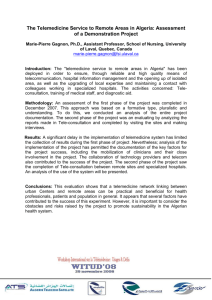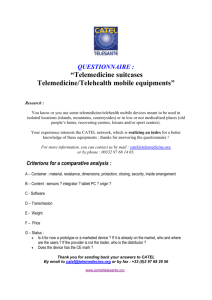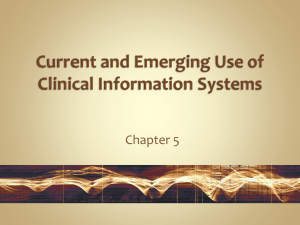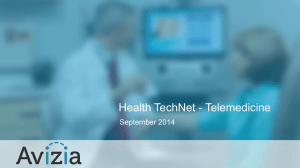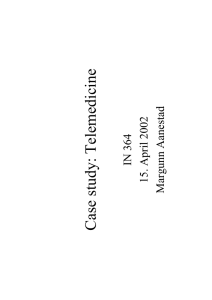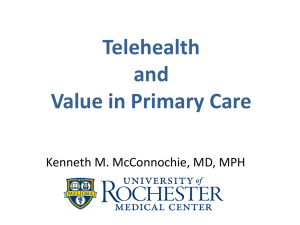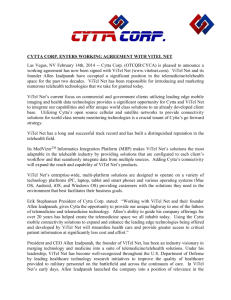Estación de Telemedicina Móvil Telemedicine Mobile Station
advertisement
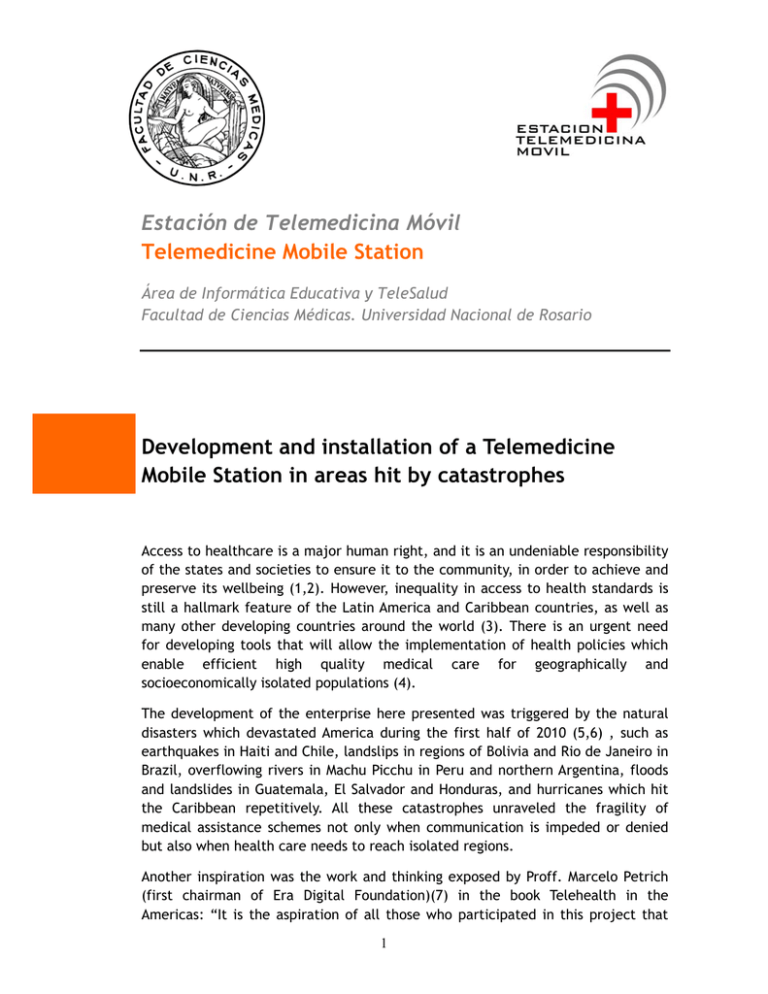
Estación de Telemedicina Móvil Telemedicine Mobile Station Área de Informática Educativa y TeleSalud Facultad de Ciencias Médicas. Universidad Nacional de Rosario Development and installation of a Telemedicine Mobile Station in areas hit by catastrophes Access to healthcare is a major human right, and it is an undeniable responsibility of the states and societies to ensure it to the community, in order to achieve and preserve its wellbeing (1,2). However, inequality in access to health standards is still a hallmark feature of the Latin America and Caribbean countries, as well as many other developing countries around the world (3). There is an urgent need for developing tools that will allow the implementation of health policies which enable efficient high quality medical care for geographically and socioeconomically isolated populations (4). The development of the enterprise here presented was triggered by the natural disasters which devastated America during the first half of 2010 (5,6) , such as earthquakes in Haiti and Chile, landslips in regions of Bolivia and Rio de Janeiro in Brazil, overflowing rivers in Machu Picchu in Peru and northern Argentina, floods and landslides in Guatemala, El Salvador and Honduras, and hurricanes which hit the Caribbean repetitively. All these catastrophes unraveled the fragility of medical assistance schemes not only when communication is impeded or denied but also when health care needs to reach isolated regions. Another inspiration was the work and thinking exposed by Proff. Marcelo Petrich (first chairman of Era Digital Foundation)(7) in the book Telehealth in the Americas: “It is the aspiration of all those who participated in this project that 1 this publication will make a positive contribution to the development of telehealth in the Americas, consolidating the commitment to a reform of the health sector based on solidarity” (2) (Fig 5). This allows us to analyze the level of evolution reached by these technologies in our regions, as well as understanding the strenght the ITU gave to these solutions. But beyond these unpredictable, although expected circumstances, the ultimate goal in the development of new technologies should be reducing inequities in access to certified health care, which are made evident by the reality these countries live daily. Telehealth contributing to reduce the digital divide. Objectives • • • • • • • In order to develop a transportable telemedicine base to be employed both in situations of natural disasters and to facilitate specialized medical care in distant geographical areas this device should meet the following requirements: Connectivity anywhere and under any circumstances Portability for any land, air or river environment Autonomous energy supply Versatility in the composition of medical peripherals appropriate to each situation Sustainability in scientific-academic medical specialties consulting staff Adaptability to local health policies and regional economic reality Cost saving implementation Project design The planning agenda included the creation of a collaborative consortium between national universities, NGOs and private companies, under the auspices of international organizations, which addressed the different aspects of construction, operation and connectivity of the telemedicine mobile station and provided academic solutions as well. This work included in a successive way: (a) construction of agile, practical and transportable container box; (b) selection and adaptation of medical peripherals to be included; (c) development of information unit, software, and supporting systems; (d) selection of media and satellite connectivity protocols; (e) designation of academic professionals to provide remote specialized assistance; (f) testing the operability of equipment in extreme conditions; (g) presentation and demonstrations at scientific-technological national and international events and to the general public through dissemination media; (h) installation of the first prototype in an area of catastrophes where socio-health was in need. 2 Results 1. Collaborative consortium The consortium consisted in agreements signed between the National University of Rosario, Faculty of Medical Sciences (FCM-UNR), the Digital Era Foundation and EXO S. A. The project had the support and sponsorship of the Telehealth Network of the Americas (8, 9) of the Inter-American Telecommunication Commission of the Organization of American States (CITEL-OAS), and the Government of Argentina –Communication Secretariat and Ministry of Defense-. 2. Development of the Mobile Telemedicine Station (ETMo) In its latest version (Version 2.0 - WiP / December 2013) the mobile telemedicine station is composed of several modules which may be selected by the user for their actual incorporation to the container • Basic Telemedicine module: composed of a workstation with 14” monitor, Bluetooth keyboard and mouse, a communications router, a specific telemedicine software, wiring and integration. • Cardio-Respiratory module: composed of vital signs monitor, blood pressure device, 12-lead electrocardiograph, digital spirometer and digital stethoscope. • Imaging module: composed of a camera for visual surface exploration, portable ultrasound transducers, light table, and direct light microscope (optional). • Medical Digital Peripherals: white light source, dermatoscope, ophthalmoscope, otoscope and laryngoscope. • Power supply: deployable solar panels, batteries, electric generator. • Satellite connection optionals • Transportation Container: storage box for telemedicine equipment provided with wheels and convertible into desktop for working place. All instruments, notebook and monitors that the box should carry as well as connection needs were considered for the container construction. Medical equipment selection took into consideration features of versatility, connectivity, compatibility, origin and cost. Efficiency, accessibility and affordability were prioritized, considering that the intention is that this telemedicine station can be used in remote locations and low income regions (Fig. 1). 3. Consulting staff A group of encompassing experts from most disciplines and medical specialties, with recognized expertise in the diagnosis, management and treatment of different situations that could arise in the very different circumstances which may require theuse of ETMo, was selected from the list of Professors of the FCM-UNR and the Heads of the specialized services of hospitals that have regular contact with the University (10) 3 4. System operability To test the operation of the ETMo in extreme conditions,, a group of physicians and technicians moved to the southernmost region of the world, transporting the container box with the telemedicine equipment by means of a regular flight to the city of Ushuaia, in Tierra del Fuego Province, Argentina with the support of the Communication Secretariat of Argentina. Upon arrival, the group and the equipment continued overland in multiple traction vehicles to Lapataia Bay, in wintertime conditions of several degrees below zero, where either no routes or nearby towns neither power or Internet connectivity were available (Fig 2. and 3) Satellite multipoint connection was stablished with a base held in the city of Ushuaia, where representatives of CITEL and delegates from the Permanent Consultative Committee: Telecommunications/ICT (PCC.I) of different countries of the OAS (11) were gathered, as well as with the Situation Room of the Telehealth Network of the Americas, located at the FCM-UNR in the city of Rosario. During the test, images and audio could be transmitted using various medical peripherals on a simulated patient, receiving real time responses from the expert group and comments from the audience. 5. Presentation of equipment and dissemination of the initiative The acknowledment of this mobile telemedicine station was nationally and internationally widespread by graphic and audiovisual material issued by Citel and its Telehealth Network of the Americas (12,13,14). Due to the recent incorporation of the National University of Rosario to the ITU as an Academia Associate member, the presentation of this project to ITU-D, Study Group 2, has been planned with purposes of gaining recognition as the most suitable option available for use in developing countries. 6. Installation and commissioning of the first prototype In early 2014, Argentine Defense Minister (15) witnessed the launch of a transportable telemedicine station in Port au Prince, Haiti (Fig 4). This equipment was specially designed to meet medical assistance necessities during natural disasters and extreme situations, enabling the request for second medical opinion to any center in the world. The ETMo was donated to the Argentinian Re-locatable Hospital (HMR) by the Faculty of Medical Sciences of the National University of Rosario and the Digital Era Foundation. The HMR is the only second level medical facility in Haiti and it is fully operated by members of the Argentine armed forces integrating peacekeeping mission set by the United Nations since 2004 in the Caribbean country. Teleconferences between the Director of the HMR in Haiti and the second medical opinion staff from the FCM-UNR in Rosario formally started on March 2014 (15). 4 Impact The development, construction, transportation and installation of a mobile telemedicine station crafted in Latin America, stresses the relevance of joining efforts in the public and private sectors in order to achieve community transcendence objectives. The initiative for the development of the device here presented rose as a response to the fragility shown by the health care system when confronting situations of the measure of natural disasters and catastrophes. Thus, the first ETMo, while ensuring portability, connectivity and energy supply, incorporated medical devices suitable solely for emergency situations. However, the reality of Latin America and the Caribbean regarding geographic and socioeconomic conditions, which are common to many other developing countries worlwide, generates options for a wider usage of the mobile telemedicine station. This will undoubtedly lead to equitable access to high quality health care under any circumstances. This is the reason why the second ETMo prototype also incorporates a modular system that allows the adaptation of the equipment composition according to specific needs, both socioeconomical and positional. In this way, the active incorporation of telemedicine workstations to Primary Health Care strategies will increase the chance of secondary level referrals, plus an actual reduction in costs due to the elimination of commutes to the hospital, both for physicians and patients, which also contributes in preventing central hospitals from overcrowding. Furthermore, the participation of local professionals and workers of the national industry enabled the development of this invaluable device at an affordable cost for developing countries, essential for the deployment of universal health policies. Perspectives The speed of progress in various areas of medical technology, informatics and telecommunications creates the necessity to continue this collaborative project incorporating those advances in order to improve the performance and adaptability of the ETMo to future scenarios. Finally, this equipment is not an isolated commercial product but a fully integrated system which works linked to an academic medical staff. There is an urgent need to organize Schools of Medicine and University Hospitals in Latin America, and in many other developing countries, to provide a comprehensive educational and research network in order to assist doctors who are not near urban centers,. The ETMo might be a suitable tool for achieving this goal. Acknowledgements Authors thank the Communication Secretariat of Argentina (SECOM) for its constant support as President of the Permanent Consultative Committee I of CITEL, the representatives of the Member States of the OAS that constitute the CCP.I of the CITEL, for supporting the creation of the Telehealth Network of the 5 Americas and this project since its inception. We also acknowledge the Authorities of the Faculty of Medical Sciences (FCM) and the National University of Rosario (UNR) Superior Council for sponsoring this project (Fig 6-7-8) ; the Secretariat of University Policies of the Ministry of Education of Argentina, who facilitate the incorporation of the project in the framework of the activities partly funded by PROMED; and the Ministry of Defense of Argentina, for transporting the ETMo to Haiti and for its installation in the Argentine Hospital in Port au Prince. This publication is dedicated to the special remembrance of Marcelo Petrich (Ɨ), ideologue, developer and enthusiastic promoter of this solidary project. References 1. United Nations General Assembly: Universal Declaration of Human Rights,Resolution 217 A (III). Paris, December 10, 1948. 2. Organization of American States, Inter-American Telecommunications Commission (CITEL): La Telesalud en las Américas: Unión Internacional de Telecomunicaciones,(2003) 3. Pan American Health Organization; Buenos Aires Declaration:Towards a health strategy for equity, based on primary health care. Buenos Aires, August 17, 2007. 4. Economic Commission for Latin America and the Caribbean: Proposed regional agenda on population and development for Latin America and the Caribbean beyond 2014. International Conference on Population and Development Beyond 2014. Montevideo, August 13, 2013. 5. Fernandez A, Oviedo E.: United Nations publication LC/L.3252: eHealth in Latin America and the Caribbean: progress and challenges. United Nations, Santiago, Chile, July 2011. 6. Guha-Sapir D, Vos F, Below R, Ponserre S: Annual Disaster Statistical Review 2010: The Numbers and Trends. Brussels: CRED; 2011. Available online at http://www.cred.be/sites/default/files/ADSR_2010.pdf. 7. Collaborative agreement between Faculty of Medical Sciences and Digital Era Foundation. 8. Inter-American Telecommunication Commission. OAS.: Resolution CCP1 Creation of the Telehealth Network of the Americas. Resolution PCC.I/RES.152 (XIV- 09). 9. Inter-American Telecommunication Commission. OAS.: Resolution CCP1 Denomination of the Telehealth Network of the Americas. Resolution PCC.I/DEC.133 (XIX-11). 10. Designation of the staff of specialists and experts for second medical opinion program. Rosario, FCM, 2010. 11. Inter-American Telecommunication Commission. OAS.: Sixteenth CCP.I Meeting. Ushuaia, Argentina, 11-14 May 2010. 12. Telam: Telemedicine transportable station. Telam Audiovisual 2010. Available online at: http://www.youtube.com/ watch?v=lxsHzjdRGYg 13. TN Ciencia: ETMo and Telemedicine. Available online at: http://www.youtube.com/watch?v=vrwn0W2qr0Q 14. Aen: Mobile Telemedicine. Available online at: https://www.youtube.com/watch?v=06gB4zpt0w4 15. Rossi A.: Debemos trabajar para que América Latina disminuya la desigualdad social. InfoNews, February 26th, 2014. 16. Argentina Joint Armed Forces: Videoconferencing commissioning Telemedicine instrumental. Available online at: http://www.fuerzas-armadas.mil.ar/Video-Conference-Telemedicina.aspx 6 Appendix Figure 1:The first ETMo prototype set in Rosario, Argentina, in 2010. Figure 2: Test run of the ETMo in Lapataia Bay, Ushuaia, Tierra del Fuego, Argentina, in 2011. Figure 3: The Argentinian Communications Secretary and President of CCPI/CITEL, Dr. Norberto Berner, the Alternate President of CCPI/CITEL Ing. Héctor Carril and the coordinator of the project at the moment of the launching of the device, Dr. Guillermo Bill. 7 Figure 4: Argentinian Defence Minister, Agustí Rossi, during the installation of ETMo in Port au Prince, Haiti, in 2014. Figure 5: Cover of Telehealth in the Americas. Developed by CITEL with the suppot of UIT and the Panamerican Health Organization. One of the foundations of this project. Figure 6-7-8: Interdisciplinary team of the National University of Rosario that developed the project. Professor Marcelo Petrich, showing the device to the former dean of FCM, Dr. Carlos Crisci Current Dean of FCM, Dr. Miguel Farroni and Prof. Natacha Dinsmann, Director of the Informatics and Telehealth Area, with haitian students who reside in Rosario, at the moment in wich the ETMo was launched to Puerto Príncipe 8
